If you’ve been reading this blog, you know that I love sand dunes. Dunes make great photographic subjects, but it’s more than that. I love just being in the dunes. When walking out to the Mesquite Flat Dunes in Death Valley, there’s this moment when you move off of the surrounding salt crust and onto the sand, and suddenly it seems as if you’re in a different world – a special realm that’s magical, beautiful, and a little surreal.
Children also love sand dunes of course. What kid wouldn’t love playing in a giant sandbox? When our son Kevin was little we took him to sand dunes whenever possible – not just in Death Valley, but to the Oceano Dunes along the California Coast, to the Kelso Dunes, and to the Imperial Dunes near the border with Mexico. He loved playing the sand, and when he was old enough we took him up the highest dune in the Mesquite Flat Dunes, which was a great adventure, and big accomplishment for him.
Death Valley’s Mesquite Flat Dunes are probably the most visited and photographed dunes in the state because they’re easily accessible, and in a popular national park. But there are lots of other dunes in California. Some of those dunes are open to off-road vehicles, which makes it hard to find trackless sand for photography. But even those places often have sections of the dunes that are off-limits to vehicles.
Every dune field has its own unique characteristics – starting with the sand itself. Some dunes have finer sand, some have coarser sand. And while all of the California dunes are tan-colored, some are lighter, and some are darker.
Some dunes are covered with more vegetation than others. Some dunes are quite high, while others are low. The Eureka Dunes, in the northern part of Death Valley National Park, are the highest in California, 680 feet above the surrounding valley. But greater size doesn’t necessarily mean greater photo potential. I often prefer photographing smaller dunes, because they’re usually more intricate, with lots of curves and facets. And I definitely prefer dunes that are brush-free.
For photography, light is also a big factor. In the mountainous terrain of the Mojave Desert (including Death Valley), most dunes are found in bowls, or up against hills or mountains. That’s not an accident. Dunes usually form when the wind picks up sand and blows it across a playa or valley floor until it reaches a mountain range, where the wind swirls, eddies, and deposits the sand at the base of the mountains. But those mountains can block the light from reaching the dunes early in the morning, or late in the afternoon, or both.
The Mesquite Flat Dunes actually lie in a fairly open valley, so they get beautiful, low-angle light in both the morning and evening (especially in the morning). They also contain sections of those intricate, smaller dunes, and more wind-created ripples than many other dunes. I’m not sure if the ripples are due to the consistency of the sand itself, or the way the wind blows across the dunes. In any case, all those factors makes them highly photogenic.
But there are many other photogenic dunes in California. Before and after our recent workshop in Death Valley, Claudia and I had fun exploring and photographing some different Mojave dune fields. We had visited some of them previously (though it had been awhile), while others were new to us.
Reaching these less-visited dunes almost always requires driving dirt roads. Sometimes you need four-wheel-drive. And you’re definitely going to need to hike. But the reward is more solitude, fewer footprints, and the opportunity to discover and photograph the unique and different characteristics of these places. We really only scratched the surface, so we look forward to going back, and going deeper. Here are some photographs from those “other” dunes that I hope show some of their beauty and character.
— Michael Frye
Related Posts: Wind, Dust, and Light in Death Valley; Dust Storm; Desert Designs
Michael Frye is a professional photographer specializing in landscapes and nature. He is the author or principal photographer of The Photographer’s Guide to Yosemite, Yosemite Meditations, Yosemite Meditations for Women, Yosemite Meditations for Adventurers, and Digital Landscape Photography: In the Footsteps of Ansel Adams and the Great Masters. He has also written three eBooks: Light & Land: Landscapes in the Digital Darkroom, Exposure for Outdoor Photography, and Landscapes in Lightroom: The Essential Step-by-Step Guide. Michael has written numerous magazine articles on the art and technique of photography, and his images have been published in over thirty countries around the world. Michael has lived either in or near Yosemite National Park since 1983, currently residing just outside the park in Mariposa, California.

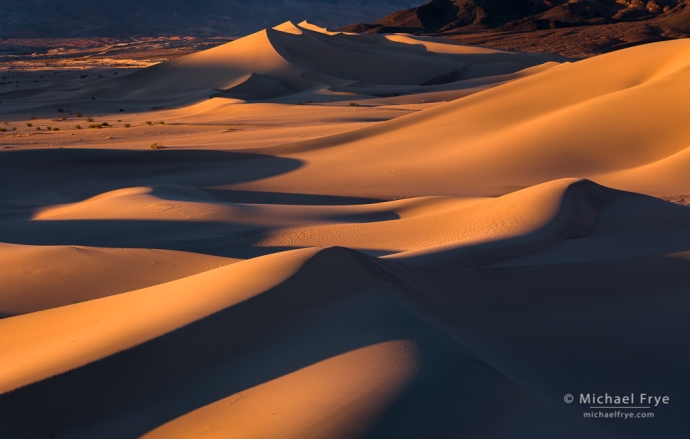
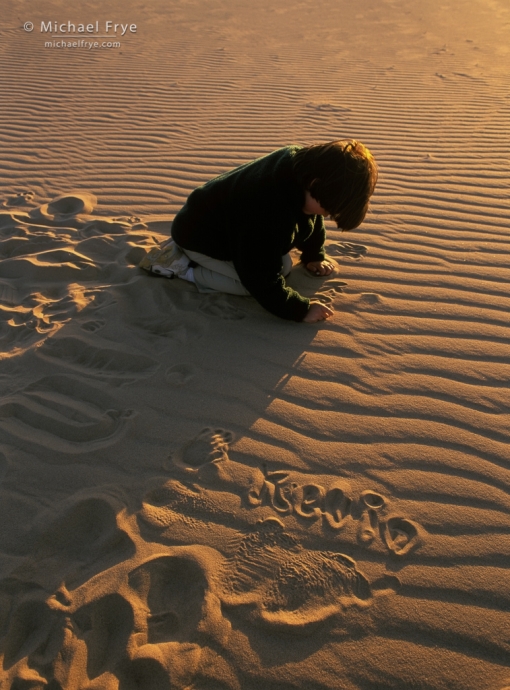
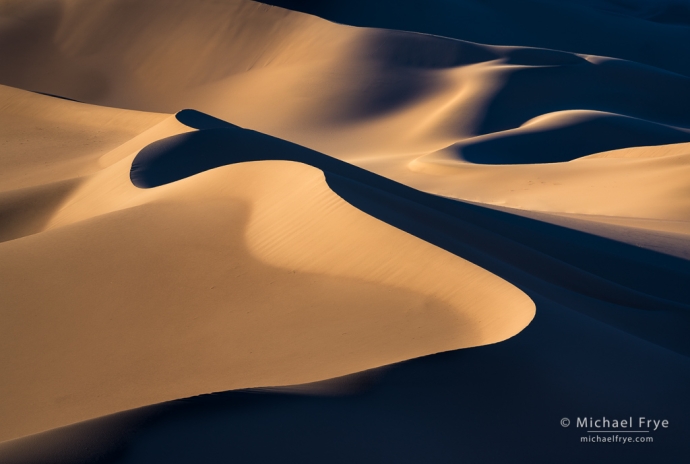

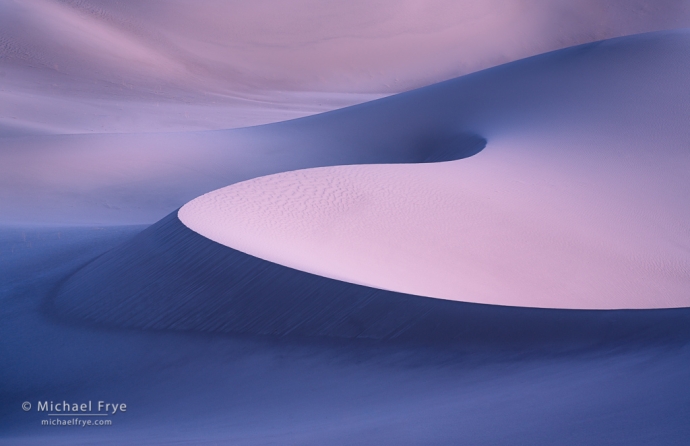
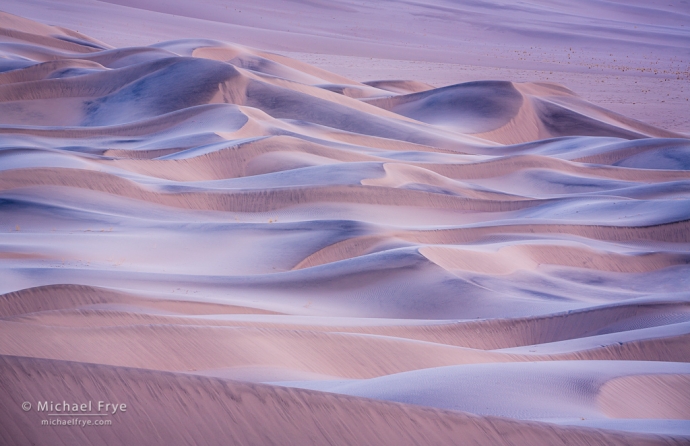
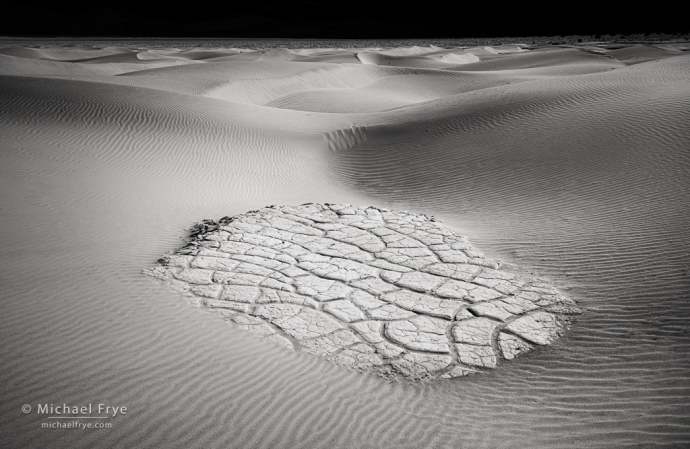
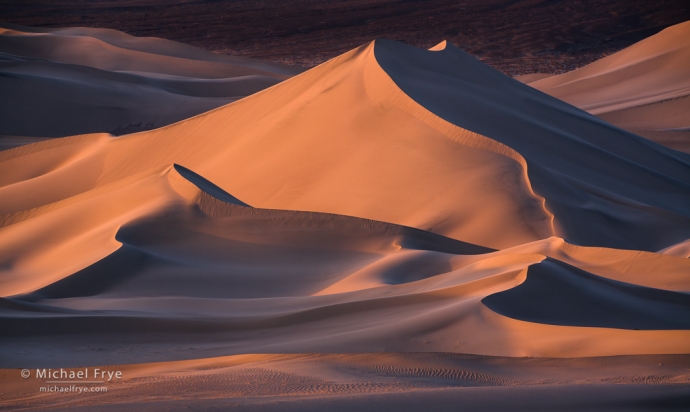








I wish my husband loved dunes as much as I do! That Curve at Dusk is breathtaking, Michael. I love the soft color, and the lines are sublime.
Thanks Vivienne! Maybe your husband needs to play in the sand more. 🙂
Amazing images! Thanks for sharing your incredible part of the world, Michael. You’ve got me wondering if there might be dunes like this near me!!
Thanks Geoff! Where do you live?
Hi Michael. I live in South Australia. There is a patch of dunescape on Kangaroo Island, locally known as Little Sahara, which is OK, but a bit scrubby, requiring close cropping to get decent lines. The Simpson Desert would probably be good, but very difficult to get to (it’s on my “one day” list, along with a visit to Yosemite!)
P.S. Sorry to Vivienne for putting my comment in the wrong place!
Well Geoff, you’ll just have to come to California! 🙂
Wow, “Curves and Waves” is really something special! Thanks for sharing!
Thanks very much Dan!
Those are all enchanting (as in mesmerizing) images. Fun to pause on each and just soak it in…
Thanks so much for sharing
Thanks very much Doug!
Beautiful images!
I’m a fan of the Kelso Dunes, but have yet to get to the top of them. Your comments about light make me think that I should try sunrise there this spring.
I think the Kelso Dunes are fairly open to both morning and evening light. I haven’t spent much time there, but there’s a lot of vegetation on those dunes, so I’d suggest looking at satellite photos to find portions that are relatively free of shrubbery. You might have to hike a bit.
Wow – you could do a book just on sand dunes, or perhaps more easily an online exhibition. The photos above are an exhibition in themselves.
Thank you
Thanks very much Graham!
Wow, Curves at Dusk is magical. Sure makes me want to get back to shooting dunes again. Bravo!
Thanks very much Anil!
As always, Michael, beautiful photography so typical of your work. Thanks for sharing.
Thanks so much Phil!